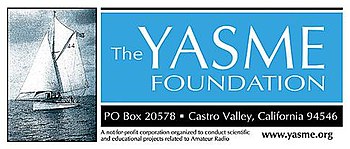The leap second refers to the slowing of the earths rotation (known as UT1) in relation to time. UTC (constant universal time) can be read by the position of the sun but since the advent of the atomic clock (known as TAI) which is for the most part constant from the time it was started, …. Click Here For more information and the 2 clockshttps://www.timeanddate.com/time/leap-seconds-background.html
Tag: sparc trivia
29 Jan 19
28 Jan 19

Loyd and Iris Colvin from the YASME.org photo gallery, many good pictures are on that site including the original YASME sailboat.
Excerpt from the About Us Page on Yasme.org:
Danny retired from active DXpeditioning in 1963. At about that time, the famous husband and wife team, Lloyd Colvin, W6KG (SK), and Iris Colvin, W6QL (SK), began what they called the “Yasme Round the World DX-Pedition” under the auspices of the Yasme Foundation. Over the next almost 30 years, the Colvins would eventually operate from over 200 DXCC countries. Yasme volunteers served as their QSL manager, issuing hundreds of thousands of distinctive Yasme QSL cards.
Supported by a sizable bequest from the Colvins’ estate in 1998, Yasme’s activities today are conducted by a Board of Directors made up of volunteers who hold or have held responsible positions in business, law and technical areas.
Source … YASME.ORG
27 Jan 19
The era of the professional wireless operator has ended. CW communications has all but disappeared from anywhere other than the amateur radio community. The maritime, airline, military, and telecommunications industries no longer employ radio operators. Computers, digital technology, cellular networks, and satellites provide reliable communications capabilities over every inch of the Earth’s surface with a reliability and reach that would have been beyond anyone’s wildest imaginations ninety years ago. In 2015, the Board of Directors of the VWOA formally redefinined the organization. It is no longer a membership organization of active and retired radio operators. – from the VWOA website
26 Jan 19
The YASME Foundation was formed to fund Danny Weil’s (VP2VB) DXpeditions on his sailboat YASME (the name is Japanese meaning to make tranquil). Danny was one of the first to travel to more than one location to operate – often solo in a sailboat and lugging hundreds of pounds of radio equipment – specifically to provide DXers with a “new one.” … From YASME.org

Source and more information at YASME FOUNDATION
23 Jan 19
Also called a “beam antenna”, or “parasitic array”, the Yagi is very widely used as a high-gain antenna on the HF, VHF and UHF bands. It has moderate to high gain which depends on the number of elements used, typically limited to about 20 dBi, linear polarization, unidirectional (end-fire) beam pattern with high front-to-back ratio of up to 20 db. and is lightweight, inexpensive and simple to construct. The bandwidth of a Yagi antenna, the frequency range over which it has high gain, is narrow, a few percent of the center frequency, and decreases with increasing gain, so it is often used in fixed-frequency applications. The largest and best-known use is as rooftop terrestrial television antennas, but it is also used for point-to-point fixed communication links, in radar antennas,[ and for long distance shortwave communication by shortwave broadcasting stations and radio armatures.
Source… Wikipedia
22 Jan 19
The Rhombic Antenna is an equilateral parallelogram shaped antenna. Generally, it has two opposite acute angles. The tilt angle, θ is approximately equal to 90° minus the angle of major lobe. Rhombic antenna works under the principle of travelling wave radiator. It is arranged in the form of a rhombus or diamond shape and suspended horizontally above the surface of the earth.
Source: Antenna Theory
Rhombic Antenna… Wikipedia
20 Jan 19
LoTW is a web-ware program done on the internet to log your contacts and through this program it will confirm your contact, this is an ARRL product and is used for ARRL Contests… For more Click Here
The International Grid Chase is a year long contest with monthly certificates (currently I cant find anything on it for 2019)… For more Click Here
18 Jan 19
Chew the fat dates back to the first time in print and that is 1885, from a book written by J Brunlees Patterson called “Life in the Ranks of the British Army in India”. In his book chew the fat was referencing army soldiers gossiping amongst themselves and the junior officers to keep from being bored. This may not be its beginning but it is for its use associated with conversation, the term does go back to when a fat soaked rag end was bitten off to be wrapped around a musket ball while loading.
More at Wikipedia
17 Jan 19
Chew the rag, although its original origin is unknown was first in print in the 1875 printing of “The Random House Historical Printing of American Slang”, and then in 1885 appeared in the same sentence in a book “Life in the Ranks of the British Army in India”.
Some speculate that the term relates too cloth and ladies sewing circles or women gossiping while quilting.
Source: Wikipedia